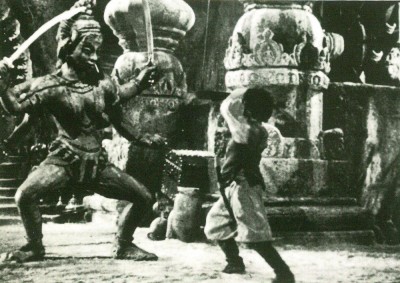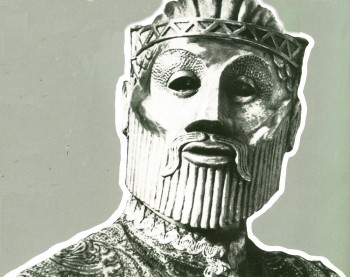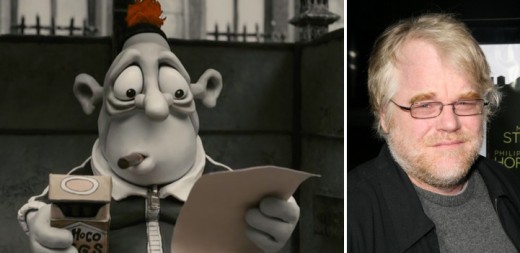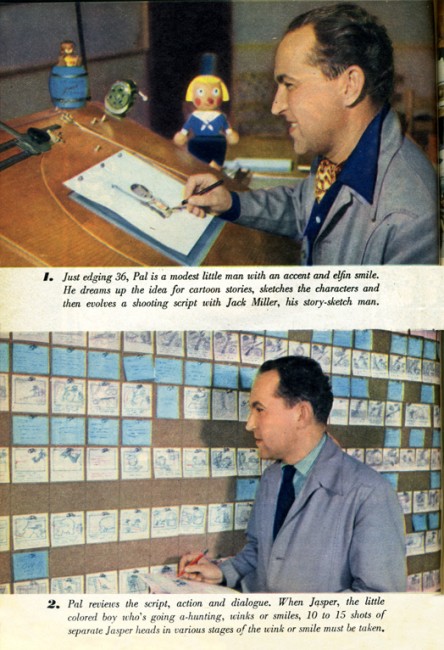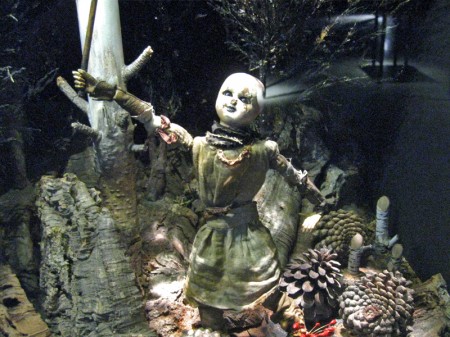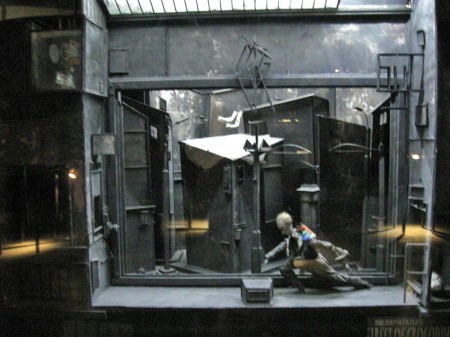Category ArchivePuppet Animation
Animation &Puppet Animation 28 Aug 2010 07:45 am
Kihachiro Kawamoto
- This last week saw the death of two Japanese animation masters. The very young (46) 2D director, Satoshi Kon, died of pancreatic cancer on Tuesday.
Then we learned that the brilliant puppet animator, Kihachiro Kawamoto had died on Monday. (Cartoon Brew has an excellent obituary for him.)
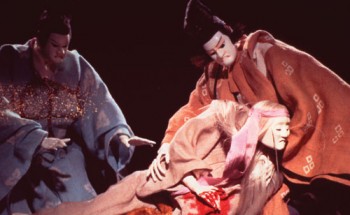 He was an acolyte of Jiri Trnka‘s, having travelled to Czechoslovakia to work with the great puppet filmmaker. Kawamoto’s own short films were gem-like little jewels which often told harrowing Japanese folk tales. Films such as The Demon (1972), Dojoji Temple (1976) and House of Flame (1979) are pure film yet they retain the spirituality of old Japanese mysticism.
He was an acolyte of Jiri Trnka‘s, having travelled to Czechoslovakia to work with the great puppet filmmaker. Kawamoto’s own short films were gem-like little jewels which often told harrowing Japanese folk tales. Films such as The Demon (1972), Dojoji Temple (1976) and House of Flame (1979) are pure film yet they retain the spirituality of old Japanese mysticism.
 Aside from the numerous beautiful short films he animated and directed, he did two features: The Book of the Dead and Rennyo and His Mother. He also supervised the cut out feature, Winter Days, a film inspired by the renka couplets of celebrated haiku poet Matsuo Basho. 35 of the world’s top animators created two-minute segments for the film. The most popular of these was Yuri Norstein
Aside from the numerous beautiful short films he animated and directed, he did two features: The Book of the Dead and Rennyo and His Mother. He also supervised the cut out feature, Winter Days, a film inspired by the renka couplets of celebrated haiku poet Matsuo Basho. 35 of the world’s top animators created two-minute segments for the film. The most popular of these was Yuri Norstein
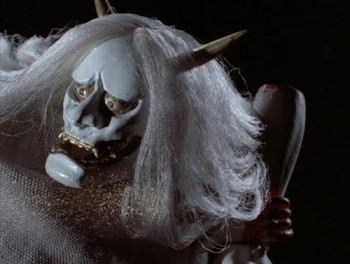 Again I saw him in Ottawa in 2006 at an animation festival. His feature, The Book of the Dead, was being screened. He spoke to an audience at a Q&A for the filmmakers. It wasn’t quite the same feel meeting him this time, but it was more relaxed and a treat, all the same.
Again I saw him in Ottawa in 2006 at an animation festival. His feature, The Book of the Dead, was being screened. He spoke to an audience at a Q&A for the filmmakers. It wasn’t quite the same feel meeting him this time, but it was more relaxed and a treat, all the same.
He died of complications from pneumonia on Monday, August 23 at the age of 85. He was a brilliant puppet filmmaker – one of the very best.
Articles on Animation &Luzzati & Gianini &Puppet Animation 22 Jun 2010 07:08 am
Magic Flute
Issue #7 of ANIMAFILM included an article about the Gianini/Luzzati feature, The Magic Flute. To keep the names of these greats in the present, I’m posting the article here. Enjoy.
by Massimo Maisetti
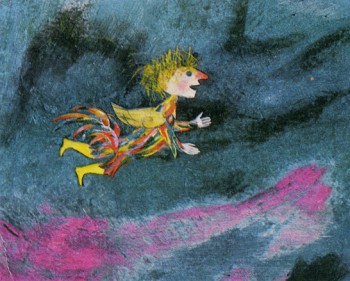 The “Magic Flute” was Mozart’s last opera, written not for the court theatre in the centre of Vienna, but for a theatre situated at the outskirts, whose manager was Schikaneder, author of the libretto. Giorgio Strehler said that it was one of the most complex and most universal works, which could be approached both from the position of the performer and the spectator. The libretto, inspired by oriental short stories, published in 1786, and by abbot Terrason’s novel, stirs up imagination, intelligence, feelings and the sense of ethics. Goethe wrote that one needed more culture to admit the values of the libretto than to deny their existence. This opinion should be thought over, as it deals with the performance staged at the outskirts in the period when to acknowledge values of a “folk” work was to oppose the accepted norms.
The “Magic Flute” was Mozart’s last opera, written not for the court theatre in the centre of Vienna, but for a theatre situated at the outskirts, whose manager was Schikaneder, author of the libretto. Giorgio Strehler said that it was one of the most complex and most universal works, which could be approached both from the position of the performer and the spectator. The libretto, inspired by oriental short stories, published in 1786, and by abbot Terrason’s novel, stirs up imagination, intelligence, feelings and the sense of ethics. Goethe wrote that one needed more culture to admit the values of the libretto than to deny their existence. This opinion should be thought over, as it deals with the performance staged at the outskirts in the period when to acknowledge values of a “folk” work was to oppose the accepted norms.
 The opera, performed for the first time on September 30th, 1791, has many elements aimed at entertaining less sophisticated audience. Next to the drama of Tamino and Pamina, which is the embodiment of the eternal conflict between Right and Wrong, the Sun and Darkness, next to esoteric elements, connected with the doctrine of freemasons, which both Mozart and Schikaneder professed, there is a counterpoint – Papageno, a purely folk character from commedia dell’arte. The opera has many aspects, but the most visible ones are its fabulous and folk aspects, and next to them – metaphysical, symbolic and cosmic aspects with their Egyptian and Hellenistic associations, making one “gravitate towards one’s conscience”, according to Kirkegaard’s words. Thus to screen the “Magic Flute” was a very difficult task, as the authors of the film rejected the possibility of screening the theatre performance. It was also difficult because they had to use a chromatic and graphic language, animating drawings, where culture and experience should be combined with great sensitiveness and invention.
The opera, performed for the first time on September 30th, 1791, has many elements aimed at entertaining less sophisticated audience. Next to the drama of Tamino and Pamina, which is the embodiment of the eternal conflict between Right and Wrong, the Sun and Darkness, next to esoteric elements, connected with the doctrine of freemasons, which both Mozart and Schikaneder professed, there is a counterpoint – Papageno, a purely folk character from commedia dell’arte. The opera has many aspects, but the most visible ones are its fabulous and folk aspects, and next to them – metaphysical, symbolic and cosmic aspects with their Egyptian and Hellenistic associations, making one “gravitate towards one’s conscience”, according to Kirkegaard’s words. Thus to screen the “Magic Flute” was a very difficult task, as the authors of the film rejected the possibility of screening the theatre performance. It was also difficult because they had to use a chromatic and graphic language, animating drawings, where culture and experience should be combined with great sensitiveness and invention.
 Giulio Gianini and Emanuele Luzzati are among the few film-makers in the world, who can perform such a task successfully. Gianini is an animator. He is an organizer, who is able to subordinate the technique to creative requirements. His characters move like puppets against the scenography. Its colour scheme is joy, music and charm. Those colours are the invention of the scenographer Luzzati, and Gianini, the master of photography (Nastro d’Argento for best colour photography in 1952), can reproduce them using his miraculous alchemic recipes. It was not a mere chance that many years ago at the Festival in Gildenbourgh he worked on Mo/art’s operas: “Don Juan”, “Abduction from Serai”, “Cos! fan Tutte” and “Magic Flute”. “I have always wanted to make such a film since the day I worked on that scenography”, says Luzzati. Twelve years of preparations, two years of work financed by the German and Austrian television, work done with patience, skill and imagination. At least three of Gianini’s and Luzzati’s films, first films of that kind, are characterized by a perfect relation between the music and the image: “La Gazza ladra”, “L’ltaliana in Algeri” and “Pulcinella”, where the charming music happily underlines the fancy, lyrical approach and ironical reserve.
Giulio Gianini and Emanuele Luzzati are among the few film-makers in the world, who can perform such a task successfully. Gianini is an animator. He is an organizer, who is able to subordinate the technique to creative requirements. His characters move like puppets against the scenography. Its colour scheme is joy, music and charm. Those colours are the invention of the scenographer Luzzati, and Gianini, the master of photography (Nastro d’Argento for best colour photography in 1952), can reproduce them using his miraculous alchemic recipes. It was not a mere chance that many years ago at the Festival in Gildenbourgh he worked on Mo/art’s operas: “Don Juan”, “Abduction from Serai”, “Cos! fan Tutte” and “Magic Flute”. “I have always wanted to make such a film since the day I worked on that scenography”, says Luzzati. Twelve years of preparations, two years of work financed by the German and Austrian television, work done with patience, skill and imagination. At least three of Gianini’s and Luzzati’s films, first films of that kind, are characterized by a perfect relation between the music and the image: “La Gazza ladra”, “L’ltaliana in Algeri” and “Pulcinella”, where the charming music happily underlines the fancy, lyrical approach and ironical reserve.
All this was expressed with the help of images in an apologue, in a stylistically sophisticated way. The above mentioned films are among the most interesting effects of using the technique of “decoup-age” in the history of animated cartoons, especially animated fairy tales. Both Gianini and Luzzati turned out to be great artists in synchronizing movements with the music of the three operas and creating three symphonies of lines and colours. Kings, soldiers, Moors, dragons and birds from those beautiful stories, created by Luzzati’s imagination come alive thanks to Gianini’s technique and move in the rhythm, forced upon them by the music and often interpret the music with the help of ballet. In this sense Rossini’s operas helped in the realization of the “Magic Flute”.
 Mickey Rose, an English musicologist, made a fifty minute-long abbreviation of the opera, performed by Berlin Philharmonic, conducted by Karl Boehm, preserving its most vital elements. At the same time the graphics enriches fantastic and folk aspects with expression. It was done with charm, amazing clearness and respect for the music. When the artists use the technique of decoupage paper becomes gold, glass becomes diamond and colours become rich and luminous, like Mozart’s music. It reminds us of such great modern painters as Rouault, Chagall, Picasso, Kandinsky, as well as of oriental wall paintings, Byzantine mosaics, story, creating a naturally composed style, rich in different shades, -where a brilliant visual side interprets and completes Mozart’s wonderful music. Finally the fairy tale aspect predominates over the symbolic aspect, also due to the character of Papageno, who plays a double role: of a paper character and a live narrator (actor Marcello Bartoli). This character in multicoloured feathers reminds its famous classic ancestors. The grandson of Harlequin and Pulcinella becomes the hero of the story, determining its character. Thus the romantic story of Tamino and Pamina concentrates the philosophic sense, which is shown in the form of a fairy tale, and is meant for a demanding audience. But the simple first layer of the film pleases children, like the films “Turandot” and “L’Augellin Belverde”, screened by Gianini and Luzzati in a similar style and technique. About seventy thousand photograms with their immobile and mobile parts, three hundred drawings of the background, creative power and enthusiasm of the authors make a work of art, which is a credit to the Italian cartoon film and deserves emotions, enthusiasm and approval.
Mickey Rose, an English musicologist, made a fifty minute-long abbreviation of the opera, performed by Berlin Philharmonic, conducted by Karl Boehm, preserving its most vital elements. At the same time the graphics enriches fantastic and folk aspects with expression. It was done with charm, amazing clearness and respect for the music. When the artists use the technique of decoupage paper becomes gold, glass becomes diamond and colours become rich and luminous, like Mozart’s music. It reminds us of such great modern painters as Rouault, Chagall, Picasso, Kandinsky, as well as of oriental wall paintings, Byzantine mosaics, story, creating a naturally composed style, rich in different shades, -where a brilliant visual side interprets and completes Mozart’s wonderful music. Finally the fairy tale aspect predominates over the symbolic aspect, also due to the character of Papageno, who plays a double role: of a paper character and a live narrator (actor Marcello Bartoli). This character in multicoloured feathers reminds its famous classic ancestors. The grandson of Harlequin and Pulcinella becomes the hero of the story, determining its character. Thus the romantic story of Tamino and Pamina concentrates the philosophic sense, which is shown in the form of a fairy tale, and is meant for a demanding audience. But the simple first layer of the film pleases children, like the films “Turandot” and “L’Augellin Belverde”, screened by Gianini and Luzzati in a similar style and technique. About seventy thousand photograms with their immobile and mobile parts, three hundred drawings of the background, creative power and enthusiasm of the authors make a work of art, which is a credit to the Italian cartoon film and deserves emotions, enthusiasm and approval.
Animation &Animation Artifacts &Commentary &Independent Animation &Puppet Animation 22 May 2010 09:05 am
Bits
- I recently received this comment from Amy Bunin, the daughter of Lou Bunin, and was afraid it might have been missed. So I’m posting it here.
 Just a note to say that my sisters and I have put our family collection of Lou Bunin’s puppets and artwork from Alice in Wonderland up for auction at Profiles in History.
Just a note to say that my sisters and I have put our family collection of Lou Bunin’s puppets and artwork from Alice in Wonderland up for auction at Profiles in History.
Lou’s stuff is on “Day 2″ of the auction. The sketches by Art Babbitt of the Dodo walking that are featured in Shamus Culhane’s Animation book (see above) –along with 10 or so other characters– are included: Lot 634. Wish us luck!
I have also started a blog on my father’s life and work – www.loubunin.com
Amy Bunin
This is an excellent blog with lots of information and stories about Lou Bunin and his work. I encourage you to go take a look.
 - John Canemaker ‘s most recent blog entry for Print Magazine is now posted and can be found here.
- John Canemaker ‘s most recent blog entry for Print Magazine is now posted and can be found here.
John writes a clear and full comparative study between the work of Albert Hurter, one of the principal designers of Snow White, and some of Giotto’s Renaissance painting.
He shows how Hurter may have been influenced. It’s a good read for any enthusiasts of Snow White, Hurter or Giotto.
Frank and Caroline Mouris have been making innovative, Independent animation forever. Their initial film, Frank’s Film, swept the world quickly and won the Oscar making a Frank a household name among animators in the 1970′s.
ASIFA-East is presenting an evening of their films on Tuesday, June 15. It’s sure to be an entertaining and enlightening event. Keep the date open to join the couple as they present their films.
Articles on Animation &Puppet Animation 09 May 2010 08:10 am
Close Up Magazine
David Prestone published a magazine in the late 70′s called Closeup Magazine. This was a professionally produced magazine that featured articles on stop motion puppet animation and special effects. Sadly the magazine stopped production after the third issue.
I’d posted a number of pieces from the second issue of the magazine, which featured interviews from many of the animators who worked on the 50′s puppet film, Hansel and Gretel. see here and here.
David now tells me that he has a number of collector’s issues still in great condition and would like to sell them. To that end, I’m posting all the information he’s sent me about all three issues, and I strongly encourage you to buy them. They’re truly gems from the past about an often neglected subject – stop-motion animation.
 CLOSEUP ONE: Our premier issue, leads off with an exhaustive thirty five page filmbook treatment of “The Golden Voyage of Sinbad” including detailed examinations of the special effects, musical score,origins of the mythological creatures used, etc. A five page article on the making of “Flesh Gordon” follows (with complete plot synopsis), and a discussion of the first seventeen episodes of the “Land of the Lost” television series rounds out the magazine. In extremely short supply.
CLOSEUP ONE: Our premier issue, leads off with an exhaustive thirty five page filmbook treatment of “The Golden Voyage of Sinbad” including detailed examinations of the special effects, musical score,origins of the mythological creatures used, etc. A five page article on the making of “Flesh Gordon” follows (with complete plot synopsis), and a discussion of the first seventeen episodes of the “Land of the Lost” television series rounds out the magazine. In extremely short supply.
CLOSEUP TWO: All interview issue. Six stop-motion animators discuss the making of such filmlas “The Time Machine,” “The
Wonderful World of the Brothers Grimm,” “Dinosaurus,” “Tom Thumb,” “Alice in Wonderland” and many seldom seen animated
television commercials. Over 100 rare, behind-the-scenes photographs. Plus: Kathryn Grant, Kerwin Mathews, and scenes from Ray Harryhausen’s latest film, “Sinbad and the Eye of the Tiger.”
Here’s a flyer that David did for issue #3:
 THE KING KONG LETTERS — The genesis of “The Making of King Kong” by Orville Goldner and George Turner-traced through quotes from correspondence with author Turner. Including interviews and comments from: Marcel Delgado, Ernest Schoedsack and Ruth Rose, Orville Goldner, Merian C. Cooper and other members of the cast and crew of this film classic. Illustrated with rare advertisements and campaign material from the super-scarce Kong 1933 and ’38 pressbooks.
THE KING KONG LETTERS — The genesis of “The Making of King Kong” by Orville Goldner and George Turner-traced through quotes from correspondence with author Turner. Including interviews and comments from: Marcel Delgado, Ernest Schoedsack and Ruth Rose, Orville Goldner, Merian C. Cooper and other members of the cast and crew of this film classic. Illustrated with rare advertisements and campaign material from the super-scarce Kong 1933 and ’38 pressbooks.
KING KONG UNCENSORED – A look at Kong’s darker side . . . Kong the killer, storming through the native village indiscriminantly killing and maiming to regain his bride. Kong in Manhattan, chewing New Yorkers, dropping women out of windows, creating havoc and wanton destruction. All of the effects scenes that were shot and later deleted (and censored) from the film, fully described, with quotes from the original Kong shooting script and hard cover novelization. Illustrated with two never before published pre-production sketches by artist Mario Larrinaga, and some of the best fan art around.
KING KONG UNCHAINED – A retrospective look at the “Fight Heard ‘Round the World” . . . Kong’s stupendous battle in the grotto with the King of Dinosaurs: Tyrannosaurus Rex!
THE KING KONG YOU’LL NEVER SEE – The full story behind “The Legend of King Kong”: Universal Pictures’ stillborn Kong remake, which would have utilized the talents of stop-motion animator, JIM DANFORTH.
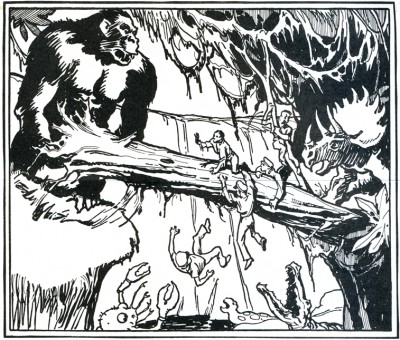
All King Kong artworkis by Glen Cravath
and was done in 1933 fpr inclusion in
the King Kong/RKO pressbook.
KING KONG DETHRONED – A talk with Rick Baker, Paramount Pictures’ Monkey Man. Things were not all mangoes and bananas for Rick on the set of the latest Dino de Laurentiis production. In an exclusive interview, this talented young man discusses his current feud 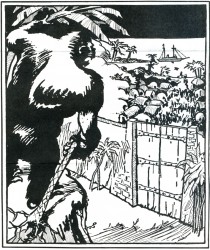 with the makers of the new King Kong film. Illustrated with exclusive behind-the-scenes photographs from the movie!
with the makers of the new King Kong film. Illustrated with exclusive behind-the-scenes photographs from the movie!
THE KING KONG CRITICS ROUNDTABLE – Several top animation fans’ opinions of the Paramount Pictures remake.
KING KONG IN PRINT and KING KONG ON ACETATE -Our regular review section, spotlighting this issue, books and records of recent vintage pertaining to the amazing anthropoid.
Features on Ray Harryhausen’s latest Dynarama effort SINBAD AND THE EYE OF THE TIGER, and the puppet filma of Rankin/Bass Productions.
CLOSEUP THREE: *Professionally printed and designed. *More pages, photos, and features than ever before. *A perfect addition to any special effects fan’s collection. *Printed on sturdy 80 Ib. gloss-coated paper in a strictly limited edition.
ALSO AVAILABLE: The Editors of CLOSEUP have obtained a limited amount of copies of a reprint booklet of a “new” King Kong novelization. This slim pamphlet, a reproduction of the English Boy’s Magazine for October 28th, 1933 has 8 fine illustrations, “How They Made King Kong,” and a full page advertisement for a Kong sequel “The Menace of the Monsters” (in which the prehistoric denizens of Skull Island are transported to England where they break loose and wreak havoc on an unsuspecting populace). Imported from England. Supply is extremely limited.
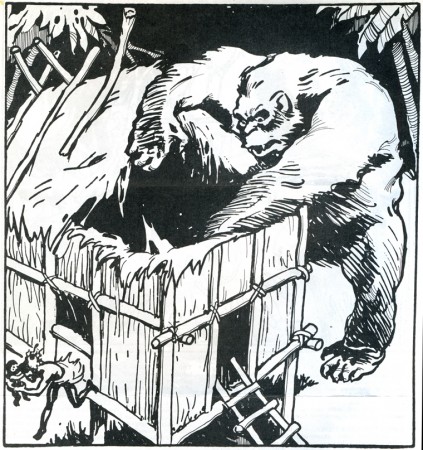
.
DAVID PRESTONE
46 -16 MARATHON PARKWAY
LITTLE NECK, NEW YORK 11362
(Checks and money orders must be made out to: DAVID PRESTONE.)
All orders have to be done through the mail.
These are all the original issues of the magazine – not reprints.
issue #1 – $50 postpaid
issue #2 – $25 postpaid
issue #3 – $25 postpaid
Animation &Articles on Animation &Independent Animation &Puppet Animation 14 Apr 2010 07:41 am
Teddy Shepard interview
- Dipping back in the well of the Closeup Magazine from 1976. Edited by David Prestone, this magazine featured articles – mostly interviews – with 3D stop-motion animators. The focus of this particlar issue was Michael Myerberg‘s Hansel and Gretel, an animated puppet feature done in 1954.
Teddy Shepard
Born in New York, Ms. Shepard became a drama major in college, and appeared in several summer stock and off-Broadway productions. It was while making the rounds of theatrical agencies in search of work that she became aware of the interviews Michael Myerberg Productions was conducting for animators. After working on HANSEL AND GRETEL, she spent some time with the Suzari marionettes, graduating to the HOWDY DOODY television show (where she originated the character of Dilly-Dally, and was a stand-in for some time as the title puppet’s manipulator), and has, lastly, been associated with the Pickwick Puppet Theater for the past several years. It was as a member of this company that she confronted the world of rock and roll music eye-to-eye, when she appeared on Broadway at the Uris Theater with the British group. Mott the Hoople. (She manipulated a Sancho Panza puppet in the song “Marionette.”)
TS; Yes, I was elected to appear witn the one big head that had been built, on a couple of television shows (TV was all live at the time) shortly after the movie had opened. I was to demonstrate how the film had been made using the heads, but we had the fake computer setup there also, to give the impression that the head was electrically operated—when it was really worked manually. We still had to keep that a big secret!
CU: Being a novice to the stop-motion process, with only a three-week training period behind you didn’t you find this form of animation slow and tedious?
TS: No, I found the more involved I got and the more intricate the movements got, that it was anything but tedious. Some time after the film was completed I worked on a few commercials for cosmetics—Hazel Bishop lipstick, and I think Myerberg was involved with these, as we filmed them in the five-story building on East Second Street he had bought. I believe we utilized the GRETEL puppet in them . . .
Speaking of that three-week training period, I remember I was petrified when it was over—I didn’t think I was ready to go immediately to work on the film, but they said, “Go onl You’re ready!” I and another person being trained acted out little scenes with some of the puppets. Animating them walking, and doing various movements of the hands . . . The scenes would be filmed and then played back for us so we could spot our mistakes. Since money was low they only filmed a few tests for each person.
CU: How did the tests turn out?
TS: Believe it or not, they came out very well! Surprisingly so! The idea was not to be jerky, but to have smooth action, moving the puppets in small increments. When doing the actual animation for the film, we would all act out the various scenes first, in front of a mirror.
CU; Were any animators assigned to do a certain character and that character only, or did you all take turns with the various figures?
TS: Since we had two crews working, when you came in to work your next shift you would carry on from where the previous people left off, no matter which figures were in the scene. It turned out that generally I stayed with GRETEL, or the mother—I did her a great deal of the time, and I did the witch one day too. You know, we had these awful stereotypes in those days … the women puppeteers would animate the female figures and the men did the males, which is ridiculous!
CU: That’s sort of a “too many cooks spoiling the broth” situation, though. Each character should really have its own “personality ” – a way of walking and moving that is that one figure’s alone, and is given to that character by one animator alone. If you recall the feature YELLOW SUBMARINE, there’s a scene where the four eel-animated Beatles are walking down a long flight of stairs, and each Beatlo has been given a very distinctive walk that’s carried throughout the entire film. You can tell which Beatle is in a scene without seeing his face!
TS: Yes. As a matter of fact, HANSEL had a definite little personality, and he would have to be done by someone who was more familiar with that kind of boyish movement, i recall, having worked with GRETEL so much, that after a while she started getting “tacky” looking and they had to have another figure of her made. They were having difficulty making her look the same as the previous model.
One strange piece of animation I and a few others worked on was a “burst of light” effect we were trying to achieve. We had 6,000 jewels on the ground on a piece of black velvet, and each jewel had to be moved separately for an effect that lasted only a few seconds on the screen. We’d be down on our hands and knees moving the gems, and people would walk by and burst out laughing!
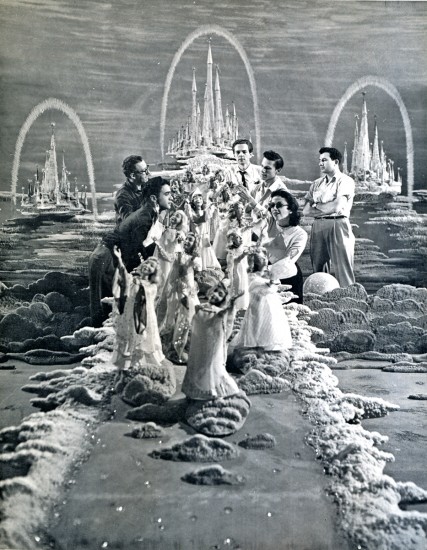
Animating the descent of the agels from their fairy kingdom.
Pictured are (clockwise) Danny Diamond, Kermit Love, Joe Horstman,
Sky Highchief, Teddy Shepard, and outside of circle (arms
crossed) Roger Caras.
CU: What’s your opinion of the final film? Do you think it would have turned out better if you had been given more time?
TS: Certainly. There was such a rush on towards the end, money was running out and we were working so hard to finish … we were all really learning the process, too. When I first saw the finished movie back in 1954, I was initially disappointed, but I think it’s held up quite well with the passage of time. And those figures were so beautiful . . . you could get so many intricate moves with them, more so than any other stop-motion models I’ve ever seen!
Other animated commercials produced by Michael Myerberg Productions during the early 1950′s (commercials whose profits were immediately used to forward production of the HANSEL AND GRETEL feature) were several for Ivory Soap Flakes (for which a mother and baby were constructed) and Ehler’s Coffee (a butler). Sometimes finished figures were built specifically to interest potential new customers. (A Kool Cigarette Penguin, and a Lil Abner model were examples of this policy.) When all plans for future stop-motion animation projects were finally abandoned, Myerberg returned to the role of theater producer for the Broadway stage.

Michael Myerberg utilized the KINEMINS technique on television commercials
as well as feature films. ABOVE AND BELOW: A GREEN GIANT figure
sculpted by James Summers, circa 1953. A Speedy Alka-Seltzer model
was also sculpted, but never used. Monetary problems continually plagued
Myeiberg, forcing many of his innovative ideas to remain on the drawing board.
ARE ANY OF THE ORIGINAL KINEMINS STILL IN EXISTENCE?
Tragically, no! In late 1955, vandals broke into the East Second Street studio and wrecked havoc among the stop-motion models and scenery which were in storage there. Most of the figurines were smashed beyond repair, but, hoping that one or two models might have been carried away intact, Myerberg notified the local police station, telling them that the KINEMINS skin was highly toxic to human beings. Unfortunately, this story brought no results.
Animation &Articles on Animation &Independent Animation &Puppet Animation 06 Apr 2010 06:15 am
Don Sahlin
- After posting some stills from Ray Harryhausen’s Golden Voyage of Sinbad, I decided to look back and see if there were any other material I could post about 3D model animation.
I came upon this interview with Don Sahlin in Closeup Magazine, no. 2. published in 1976 by David Prestone.
(Bio)
 Born in Stratford, Connecticut, Don Sahlin (say—lien) was introduced to the world of marionettes at age eleven, when he saw a production of HANS BRINKER AND THE SILVER SKATES by the New York Marionette Guild.
Born in Stratford, Connecticut, Don Sahlin (say—lien) was introduced to the world of marionettes at age eleven, when he saw a production of HANS BRINKER AND THE SILVER SKATES by the New York Marionette Guild..
Joining the PUPPETEERS OF AMERICA organization, he was soon inundating many of that group’s members with letters of inquiry as to the correct method of constructing and performing marionette shows. This correspondence brought Don an offer from Rufus Rose (who, several years later, was to create all of the figures for the HOWDY DOODY televison show) to spend several weekends with Rose and his wife as an apprentice.
.
In 1946, Don started another apprenticeship of many years standing when he began working with Martin and August Stevens, who performed sophisticated marionette dramas of subjects like Macbeth, Joan of Arc, and Cleopatra.
.
A stint of Summer Stock in Rhode Island followed, when Don felt he would try his hand at the acting profession, but he soon became disenchanted with this form of theater work. In 1949, Don traveled to Hollywood, where he worked with puppeteerist Bob Baker, doing party shows for many of the movie stars there.
.
Don then returned home to perform a show of his own designing, SAINT GEORGE AND THE DRAGON, which played around the Connecticut area. Later jobs involved working with very large puppets accompanied by a symphonic orchestra, Chinese shadow plays, and, in 1950, a marionette version of the LAND OF OZ stories that Burr Tilstrom was preparing as a television pilot. Working for a year on this project, Don was then drafted into the army.
CLOSEUP: How did you first get involved with stop-motion animation?
.
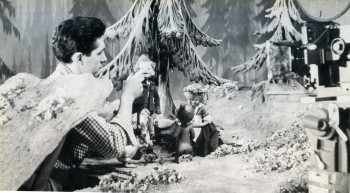 DON SAHLIN: When I got out of the Army in 1953, I had heard that Michael Myerberg was looking for puppeteers to work on HANSEL & GRET-EL. For some reason, he thought that puppeteers would make better animators than (stop-motion) animators! I was interviewed and got the job. I had to then go through a three-week training period with Myerberg in order to better acclimate myself with stop-motion. It was a very bizarre setup.
DON SAHLIN: When I got out of the Army in 1953, I had heard that Michael Myerberg was looking for puppeteers to work on HANSEL & GRET-EL. For some reason, he thought that puppeteers would make better animators than (stop-motion) animators! I was interviewed and got the job. I had to then go through a three-week training period with Myerberg in order to better acclimate myself with stop-motion. It was a very bizarre setup..
CU: Do you recall who sculpted the puppets?
.
DS: A man by the name of Jim Summers did the sculpturing. As I recall, they had a special machine shop where all the armatures were constructed. I’d give anything to own one of those armatures now. They were pieces of art.

James Summers applies makeup to an almost finished Gretel.
Inset: Clay heads by Summers.
Below: Evil Witch Rosina Rubylips views herself
as portrayed in a preproduction sketch.
.

CU: Were they all ball-socket in construction?
DS: They were, but you’d press levers, which was really interesting. If you wanted to move the thigh, for instance, you’d press a little lever near the thigh area which would release it for a tiny movement. Removing pressure from the lever would freeze the puppet in position. As you may know, they were all held on the stage with electromagnets.
CU: Could you elaborate on how that was done? It’s interesting that Myerberg used that method of support as opposed to the tie-downs used by today’s animators. . .
DS: The base of the stage was all metal, and they had these strong electromagnets underneath. The puppets really clomped down on them. Of course, we’d have to break the electromagnetic field in order to move the legs to their next position. One night, as I remember, we were working on a very hard scene. Myerberg had a twenty-four-hour shift there, and the animation varied so greatly because people would come in and start animating where the day-shift had left off! We went out to dinner, and somehow, somebody had hooked the electromagnets into the main power source. Naturally, we killed all the lights as we went out. As we pulled the switch, we heard a series of plops. All the puppets had fallen over! We had to start the whole thing all over again! I quit twice on that film … I never got screen credit, because I quit before it ended.
CU: Here’s a quote from the book Puppet Animation in the Cinema: “The Kinemins used in HANSEL & GRETEL . . . were controlled by the use of electrical solenoids, and electromagnets in the feet. . . a system which is a closely-guarded trade secret…”
DS: (Laugh) That’s a lot of bunk, you know. The only thing “electronic” was the electromagnetic setup that held the puppets on the stage. Myerberg had a big panel upstairs where he’d use close-up heads that were wired to this big, blinking board. You’d turn knobs, but there was nothing electronic involved. There was simply a wire inside the mouth, and with a twist of a certain knob, the mouth would go “that way,” and so on. But it was all manual. Anything else that was said was a big put-on.
CU: A similar incident occurred with the publicity on Ray Harryhausen’s 7TH VOYAGE OF SIN-BAD, where the reporters of the media were quot-iny the producer on how the skeleton fight was “electronically” controlled . . .
DS: Nothing but press stuff, I would imagine. I’m glad you mentioned Harryhausen. God, I love his work. The one I saw recently again that I just adore was JASON AND THE ARGONAUTS. His work was absolutely superb. Classical mythology is such a wonderful area to explore. Why don’t they do more things like that?
CU: We’ve been asking ourselves the same question !
DS: Those skeletons were frightening! You know, I’ve learned to enjoy animation more now because I’ve been away from it for so long. But it’s a curious thing. Do you remember Trnka’s A MIDSUMMER NIGHT’S DREAM? I saw it again and fell asleep through most of the whole thing! I was just so aware of how long it took to do each scene that it fatigued me … But it was a beautiful film.
CU: Getting back to HANSEL & GRETEL. Who actually did the camerawork on it?
DS: That was a very strange thing. Myerberg hired Martin Munkasci to photograph the animation. He was one of the great still photographers and had done a lot of things with Garbo and so on. Oddly enough, Myerberg felt that since stop-motion was nothing but a series of still frames, a capable still photographer would be more appropriate to do the camerawork. It was a very strange rationale on his part. Martin knew virtually nothing about motion pictures. Fortunately, a very fine Acme camera was used which was simple to operate, and he would just line up the shots and photograph. Anyhow, we went nuts, going up and down opening and closing those trapdoors all night long, sitting under that stage! And those sets were gigantic. Many of the backdrops were paintings, but a lot of it was also dimensional.
CU: We know that Myerberg isn’t with us anymore. What became of his organization after HANSEL & GRETEL?

Above: The beginnings of the KINEMINS . . .
incomplete sculptures of Hansel and his father .
Below: Several puppet figures and a set (which predate all work
on HANSEL AND GRETEL) from ALADDIN AND THE WONDERFUL LAMP.
All sets and puppets for this project were put aside
once work began on the Humperdink musical.
.
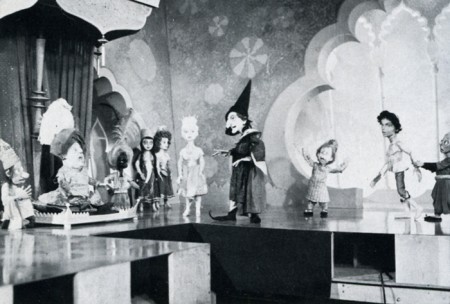
DS: Myerberg had all sorts of aspirations to do other things, but they never materialized. I think his sons own the film now.
CU: Where did you go from there?
DS: After I left Myerberg, I was in association with Kermit Love, who had also worked on the film. We were going to do a full-length motion picture Of Beatrix Potter’s TAILOR OF GLOUCESTER. It’s a charming story about a tailor and a Whole community of mice. We were going to animate all of the mice. We had the whole thing set up in London . . . Robert Donat was signed to play the lead role and Margaret Rutherford was also cast for the film. We began building the mice and we had some funding, although we hadn’t gotten to the point where we were able to build them all. Suddenly, we had a bad partnership and the whole project collapsed.
CU: Would the animated mice have been combined with live actors in the same scene?
DS: No, they would have been separate. I don’t really like it when they combine things, although Ray Harryhausen is a master at it. I wouldn’t want to do it in that way, but I respect what he does very much. Anyhow, I returned to the States when our TAILOR OF GLOUCESTER failed, and then got 3 call to go out and do work on TOM THUMB. That film, I think, was the most enjoyable thing I worked on during this period, because it was my first big job in Hollywood.
CU: How did you get involved with George Pal?
DS: At the time, 1 had been out in California working with a puppeteer friend of mine named Bob Baker. When TOM THUMB began, I was asked to build a little six-inch stop-motion marionette of Tom that they were going to use in the long shots. It was a funny thing. They said that he had to wear a fig leaf, so I carved this puppet with ball and socket joints, and he really looked naked. George was in England shooting in 1957, and decided that he wanted the puppet for a particular scene. But all my work was in vain, because the fig leaf that Tom wore covered almost his entire body. I had thought that the fig leaf would be in scale with his body, but that’s not the way it turned out. I think Wah Chang has the little Tom Thumb figure now, but I would love to own it. It was really an exquisite little puppet. It was all carved out of walnut, and I filled the legs with lead to make them heavy. It was never used in the closer shots, just distance stuff.
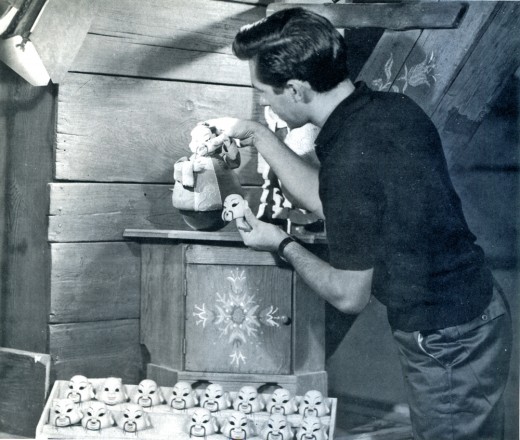
Two photos illustrating the replacement method of animation, utilized on TOM THUMB.
Instead of achieving changes of expression through manipulation of a stop-motion model’s
facial features, a series of heads are prodced, each head having a slightly different
expression on it. Changes are made by simply substituting one head for another.
Above: Don Sahlin placing a head on Con-fu-shun, and
Below: Numbered heads created for The Yawning Man animated by Gene Warren.
.
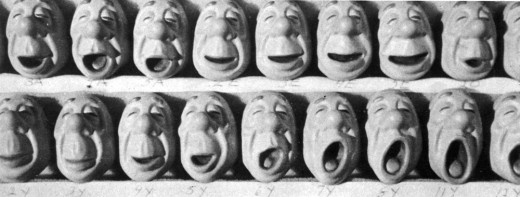
CU: How did you get to be a part of Project Unlimited?
DS: After I had carved the little stop-motion marionette, they started filming all of the animation sequences, but 1 had to go back to New York. Then Bob Baker called me from California and told me that they needed an animator. I talked to Wah Chang, I think it was, and he said, “Come on out and work for us!” 1 worked out at Project until about 1962. They wanted me to stay on, but Burr Tillstrom of Kukla, Fran and Ollie fame wanted me to come back to New York to work with him on a Broadway show. And it’s funny how fate is. I didn’t want to go; I really loved working at the studio, especially after THE TIME MACHINE. Anyhow, I did go to work for Burr on this small, cabaret-type show at the old Astor Hotel, but it soon folded. And like I say, 1 regretted leaving Hollywood, but I also met Jim Henson of the Muppets here in Mew York, and it led to probably my most successful period.
CU: Could you tell us just what you animated on TOM THUMB?
DS: I animated Con-fu-shun, a lot of the little guys that just popped up, and the Jack-in-the-Box. Gene Warren and I did all of the animation, just the two of us. Gene is a marvelous animator; he did the Yawning Man sequence. I spoke to Gene a little over a year ago, and I was so happy to find out that he does my favorite commercials—Chuck-wagon! To me, the most charming commercials ever done!
CU: What were some of the techniques used in animating Con-fu-shun?
DS: I remember Con-fu-shun was a very simple puppet. The armature was bolted to the stage and he just rocked. Occasionally, I think he got off for a couple of drop shots. The facial expressions were accomplished by replacing just the faces, which were made out of wax. We had a whole tray of all his faces. We’d just put on “E1″ or “E2,” or “Smile 1,” “Smile 2.” I know his eyes were not connected to the face; they were always independent. The faces just slipped on in perfect registration. I remember the little eye-pick I used for animating his eyes; it looked like a little hypodermic needle.

The TOM THUMB marionette created by Don Sahlin and used only in long shots.
CU: Did you have anything to do with constructing the large prop furniture, or giant hands and horse’s ears, that Russ Tamblyn was to interact with?
DS: No, that was all done at MGM, in England. Project Unlimited was a kind of neat little studio by itself, completely independent. Pal would do all of his stuff at MGM, but I wasn’t involved in the work done there, even on THE TIME MACHINE.
CU: You did some work on DINOSAURUS. Could you talk a bit about it? We know that,the models were built by Marcel Delgado, but little is known about who actually did what as far as the animation goes . . .
DS: I animated the Tyrannosaurus and the fight scenes that were involved with it. The rest of the animation was done by myself and Tom Holland; he got to do most of the Brontosaurus, the less ferocious of the creatures. I remember the night we finished the scene where the Brontosaurus died in the quicksand. The material used for quicksand was Fuller’s earth; I guess it’s used because it looks in scale. We had a kind of screw-jack that the puppet got on, and we kept pulling it down slowly in stop-motion, beneath the surface of the quicksand. When we finished the scene, we were exhausted. Then we asked ourselves, “Should we leave him in or take him out,” this great piece of sponge rubber? So we pulled him out again and we were hosing him off and cleaning him up. It was funny!
I also remember the night the big dinosaur fight took place. They were playing Stravinsky’s Rite of Spring in the background and boy, it really inspired us to animate! We got through that fast, where they were tearing and ripping at each other.
CU: Is Tom Holland still animating in Hollywood?
DS: I don’t know what Tom is doing now. It’s interesting; Tom wasn’t really an animator. He was an actor, primarily, and he somehow got involved in animation. We did all of those scenes together. I recall another amusing incident on DINOSAURUS. Do you remember those close-up shots of the manually-operated dinosaurs that we intercut? We once spent a whole day boiling ochra and straining it to make it look like saliva was really dripping from their mouths. It was just hideous!
CU: DINOSAURUS is an interesting thing to look at as an animation film, but technically, it did seem to be somewhat under par in comparison with some of the others. . .
DS: It was a very cheap film. A lot of the rear projection work was just awful, especially the scene at the beginning when the guy came running out of the shack and the dinosaur came to life. Those shots were far from pleasing.
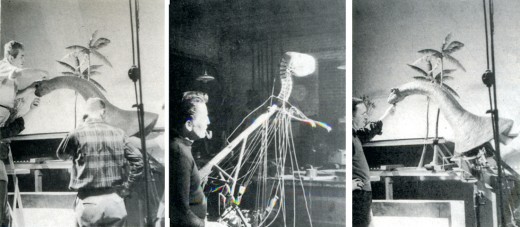
Project Unlimited technicians working on the large
manually-operated dinosaurs created for DINOSAURUS.
Left: Marcel Delgado applies the finishing touches to the Brontosaurus mockup.
Middle: Tom Holland and the Tyrannosaurs Rex “skeleton”.
CU: How big were the models in DINOSAURUS?
DS: Most of them were relatively small, except for the Brontosaurus, which was awfully big. You probably remember that we had a little doll of a boy riding on its back. I have a theory that large figures are hard to animate. Something happens, some strange phenomenon, which I can’t understand, takes place. I guess I’m not that kind of a perfect animator; I sort of do it loosely. I did TOM THUMB because that was all very contained. I got a lot out of the character as far as hand movements and so on. But the stuff that Jim Danforth did for BROTHERS GRIMM was just so superb that I would go insane doing that. I’m really into marionettes; I think that there’s a lot of potential in them for fantasy films in certain instances. I remember telling Gene Warren about some of those long shots where they were Trudging through the jungle in DINOSAURUS: “You know, I could do that better with marionettes.” I really think that one can augment the two.
CU: Project Unlimited also did some work on SPARTACUS…
DS: Yes, our little studio was always doing unusual props and effects for films, in between our animation jobs. Kirk Douglas was producing and starring in a monumental production of SPARTACUS, and Project Unlimited was called in to make about ‘ two or three hundred dead bodies, in various f scales, for some of the battle scenes. The largest * were about one-third life-size … We used molds to make them, and then we’d dress them in armor and sort of strew them all over the battlefields. I then i had to slash and “gore them up” with fake blood! We also made a bunch of horses out of polyure-thane foam. They weren’t very detailed, though-we just had to make sure they’d be recognizable from a distance, but none of them were shown in closeups.
CU: What did you do on THE TIME MACHINE?
DS: I worked on virtually all of the special effects.
There really wasn’t much animation, other than the decaying Morlock. That was done by Tom Holland. You know, I was in that film! I made my “screen debut.” Remember the guy in the window changing the clothes on the mannequin? That was me! I didn’t want the job because there was an actor there who worked with us, Dave Worrick. I asked them to give the job to Dave because I had no real desire to be in films. But they said, “No, we want you to do it.” So they got me a costume and animated me for the scenes.
CU: You mean you were actually pixillated as opposed to just speeding up the camera?
DS: Yes. I literally went in and they animated me per frame. The really neat thing about changing all of those costumes dealt with the fact that they were brought in from MGM. Somehow, in my subconscious mind, I recognized them. I remember saying to myself, “I’ll bet that’s a Lucille Ball dress.” Sure enough, it was, as their names are all sewn in them. But I loved the Morlock scenes. Some of the things I wish I had taken were a pair of Morlock feet and a Morlock head. They were great works of art; really spooky to look at! 1 animated the airplanes and dirigibles in the World War II scenes, but I never thought they were very realistic.
CU: In the earlier part of the film, there was a split-screen shot where boiling lava came oozing down the street. . .
DS: That was a great big fiasco, you know, because it didn’t really work. They had built these two bins full of colored oatmeal for the lava. One day, they decided to do a take. They covered all of the set with polyethylene. Now, they had prepared the oatmeal the night before, and nobody got up to look at it. Then they pulled the traps, with all these high-speed cameras going, and all the oatmeal had fermented and became watery. And the sight of all that! If I could have had a picture of the faces on those people! This foul-smelling, fermented mess came rushing down over all the cameras. I just went home. When they did the take again, they had put too much stuff together and it was too thick. I believe that’s how it appeared in the film. We were busy throwing burning cork and silvery material into the oatmeal, but it really didn’t work too well. It was fun, though.

Don Sahlin on THE TIME MACHINE set.
Down this street will come the colored oatmeal “lava” flow.
CU: There was some inconsistency with the shot of you changing the mannequin. If the sun had been rising and setting at the speed depicted in the film, you shouldn’t have been able to see a man change a mannequin at all…
DS: Right. There are a lot of inconsistencies in that picture, but they’re very minor. It’s such a charming thing to watch. I never get tired of seeing it; it has such a haunting quality to it.
CU: Even the music and the actors seemed perfect.
DS: It did have a good score. Rod Taylor certainly seemed to be suited for the role. I had never been much of an Alan Young fan, but he played that triple role beautifully. And Yvette Mimieux was just out of high school at the time. The sound effects were great. I especially loved the off-camera sounds of the kettles underneath the ground.
CU: Did you work on the explosion scene towards the end?
DS: We had an incredible effect for that. We built a huge miniature set, about the size of a good-sized living room. It was all done on different levels of tables. We had legs underneath; and it was like a big puzzle. The legs were pulled at different times so the set would collapse. Then there would be explosions and flash-pots going off. It was really effective. There were many other scenes in THE TIME MACHINE that I worked on. There was the opening scene of the candles melting, and the ones of the flowers blooming. I remember we animated a snail; I also animated the Sphinx. You might recall the raising and lowering of those siren towers …
CU: Were they cardboard cutouts or was it a full miniature?
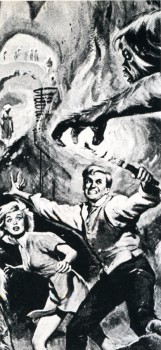 DS: It was dimensional. But there was very little animation involved in that. There was another scene, a blue-backing shot, where layers of lava were made to appear rising behind Rod Taylor in his Time Machine. That was all painted. They had a guy in another room, Bill Brace, an artist, and he was doing all those matte paintings where the trees were blooming and the apples were growing. And he painted the future scenes, too, where you saw the topography of the land changing, and the Eloi temple being built. The whole dome of that was a painting matted in, and the stairway leading up to it was part of MGM’s old QUO VADIS set.
DS: It was dimensional. But there was very little animation involved in that. There was another scene, a blue-backing shot, where layers of lava were made to appear rising behind Rod Taylor in his Time Machine. That was all painted. They had a guy in another room, Bill Brace, an artist, and he was doing all those matte paintings where the trees were blooming and the apples were growing. And he painted the future scenes, too, where you saw the topography of the land changing, and the Eloi temple being built. The whole dome of that was a painting matted in, and the stairway leading up to it was part of MGM’s old QUO VADIS set.
Do you know what I loved about working on TIME MACHINE? We literally did the sets ourselves. I loved doing the sets and dressing them. We were all very involved in the whole project instead of just one aspect of it. I remember working on that huge hole that Rod Taylor climbed into to get to the Morlock world. I loved getting down there, touching it up with a spray can and adding little details to it. I really feel proud to say that I worked on THE TIME MACHINE; I think it was a classic. I never received screen credit due to the politics of the organization, but it never bothered me. We were working on a very small budget. I think I remember Gene telling me that we did the effects for under $60,000, which was really a smal sum, yet it reaped an Academy Award. Have yot ever met George Pal?
CU: We’ve never had the pleasure.
DS: When you think about him, he was such an unusual producer when you realize the courage he had to have to do the kind of offbeat things he did.
 CU: The last film you worked on for him was THE WONDERFUL WORLD OF THE BROTHERS GRIMM. Could we talk about what you did on that one?
CU: The last film you worked on for him was THE WONDERFUL WORLD OF THE BROTHERS GRIMM. Could we talk about what you did on that one?
DS: I did a lot of the animation, especially the scenes involving the elves. The opening scene of the elves took me a whole week to do. Dave Pal and George’s other son, Peter, worked with me. We got along famously. I had to leave before the picture was over, so Dave carried on from where I left off.
CU: Did you work with Jim Danforth on the film?
DS: Not directly. I was in one corner of the stage, and Jim was working in the other corner. It was so tedious because of the Cinerama camera. Each frame had to be photographed three times. You had to be careful not to make any mistakes. We couldn’t talk at all. Peter would work the camera and we made it a point never to talk to each other because it was so easy to make an error. I was animating five elves, and he had to work that complicated turret camera.
CU: Didn’t you have to brace some of the elves? Some of them had to leap off the stage. . .
DS: Yes. We had a lot of wire stuff on the film. The wires were very thin and they were coated with iodine. You really couldn’t see them. Each time we’d reposition the puppet, the wires would be in a different part of the frame. So they really cancelled themselves out.
CU: Did anything unusual happen on the animation set?
DS: I do remember one funny thing that happened on BROTHERS GRIMM. There was a scene where an elf walked across the set with a shoe. The peg holes, by the way, were covered with clay and painted to match the set each time the elf took another step. Anyway, one of my little mice from the aborted TAILOR OF GLOUCESTER project got into a frame while the elf was being animated. Just for one frame. It was a terrible thing, but Pal never saw it!
CU: Did you do anything outside of the elf sequences?
DS: Wah Chang set up all of the shots and lit them. While he was doing that, I loaded the camera, which to this day frightens me because I don’t consider myself that technically inclined. I also did all of the calibrations and animated the camera for trucking shots. All the fades and the simpler opti-cals were done in the camera.
CU: Did you actually plot out all of the animation before it was photographed?
DS: We had to on some of the things. When there are faces involved as there were in TOM THUMB, and you have to do all the vowels and so on, you have to plot them out beforehand. But I like to animate sort of “free;” I don’t like to be restricted too much. You mentioned Jim Danforth before. I believe I met him while I was doing TOM THUMB. He was very young at the time and was very wide-eyed at what was going on. He seemed so impressed with our setup. Then I saw his reel that he had done in his garage. He did incredible stuff, op-ticals and everything. He’s a genius; he really is an incredible animator. He’s so much better than I am because I haven’t the patience to do the detail that he does. I remember him animating the dragon in BROTHERS GRIMM. He did that whole thing, and he spent days with all sorts of pointers. He’s a perfectionist.
CU: Now that you’re no longer involved in stop-motion, could you tell us about your work with the Muppets?
DS: I build and co-design Jim Henson’s puppets. He starts out with a little thumbnail sketch; I would say that he really creates the essence with his sketch. Then I start building it. Jim comes in and looks at it and we play with them to see how well they’ll work. But it’s really a joint effort, although I don’t do any of the puppeteering. I built many of the most famous of the Muppets. Kermit the frog, Bert and Ernie, the Cookie Monster, and most of the others.
CU: You did two “counting films” for Sesame Street. . . were these very recent?
 DS: Not really. They were done around 1970, right here in our Muppets, Inc. offices. Jim Henson supervised the filming, but he gave me all the freedom in the world to do what I wanted. THE QUEEN OF SIX was filmed on a rug, to simulate grass, and the backgrounds were all painted cardboard. The Queen figure was about 13 inches tall and I wanted her to have a very baroque, dresden sort of look. Her hoop skirt was a big lampshade that I put brocade on. She had a beautiful Marie Antoinette wig that I made out of silver thread, and I used one of those plastic Easter eggs you can buy for her head.
DS: Not really. They were done around 1970, right here in our Muppets, Inc. offices. Jim Henson supervised the filming, but he gave me all the freedom in the world to do what I wanted. THE QUEEN OF SIX was filmed on a rug, to simulate grass, and the backgrounds were all painted cardboard. The Queen figure was about 13 inches tall and I wanted her to have a very baroque, dresden sort of look. Her hoop skirt was a big lampshade that I put brocade on. She had a beautiful Marie Antoinette wig that I made out of silver thread, and I used one of those plastic Easter eggs you can buy for her head.
CU: I recall the other “counting film” you did, THE KING OF EIGHT, with the rhyme-speaking king, and his eight daughters opening and closing the windows of his castle. Both of these films were fairly short, weren’t they?
DS: Yes, none of those films done for Sesame Street are over a minute in length.
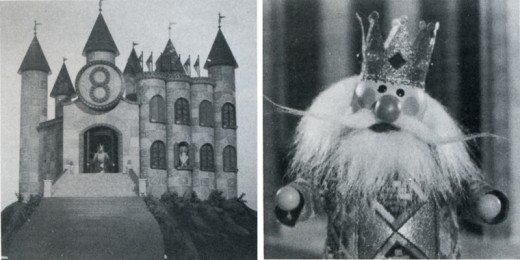
The King of Eights
CU: Are you satisfied with the work you’re doing now?
DS: Certainly. It’s very creative and enjoyable. I remember that when I was a kid, my sister wanted me to take regular college courses. I told her I wanted to take art courses. She would say, “What can you do with art? You’ll never make a living do ing puppets.” And it was only recently that we reminisced about that and, not trying to sound egotistical, I said to her: “Do you know that my puppets are all around the world?” Now that Sesame Street has been distributed in Europe, I have great satisfaction in knowing that my creations are
being seen and enjoyed internationally.

Don, as he appears today, with some of his more
“gruesome” creations for the Henson MUPPETS.
Animation &Puppet Animation 03 Apr 2010 07:53 am
Bill Benzon/Harryhausen

- Bill Benzon has been writing some particularly fine pieces for The Valve, and he just posted a lengthy and heady article called The Rings of Fantasia. When Bill notified me about the piece, I asked if he minded my reposting on my site, and we agreed to go ahead with that. However, after doing all the work of setting it up, I’ve decided it’d be wrong to do so. It’s better just to link to it so that The Valve, the original site that Bill regularly writes for, will get as much attention as it deserves for showcasing such a writer as Bill.
I suggest you check it out and read some of the many other pieces Bill’s written. He’s a great supporter of Nina Paley’s work, currently highlighting the web comic strip she’s doing, Mimi and Eunice. (It’s good to see Nina creating again after the long promotional wind-down of Sita Sings the Blues. By the way, Bill Benzon wrote a wonderful and positive piece for The Valve about that film, as well.)
So in the end, let me encourage you to go and read. There’s some great stuff by Bill Benzon at The Valve.
- Clash of the Titans opened yesterday to mediocre and negative reviews. Watching trailers for this film made me sad to see the work of Ray Harryhausen tramped on by the cg generation. There’s no possibility a computer driven model could carry the same weight that the magnificent creatures of Harryhausen brought to the orginal. His films were always annoying in that they had a bevy of bad acting and live-action direction all in the service of the brilliant effects. Harryhausen’s creatures were the real stars of his films whether Jason and the Argonauts, either of his two Sinbad movies or Clash of the Titans. Even watching the clips of the cg effects brought me down. Something about the original’s stop-motion jerkiness added a weight, a reality to the form. The computer effects have become so generic that to go from this film to even the Mummy movies becomes almost interchangeably tedious. There’s basically no difference and no reason to see the film.
Instead I did see a running of the original and several other Harryhausen films on TCM recently. The mix of greatness and the B-movie live-action was almost delightful. These films have become iconic, and they’re irreplaceable.
To honor Harryhausen, I want to post some production stills. I don’t have pictures from his Clash of the Titans, but I do have plenty on The Golden Voyage of Sinbad, the film just prior to that. So here are some of those images.
 1
1(Click any image to enlarge.)
 2
2
The original drawing of Sinbad and his men
fighting the golden Kali.
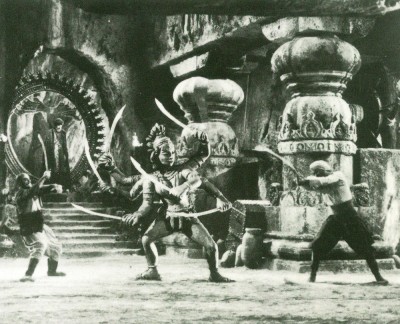 3
3
The golden Kali comes to life.
 4
4
Very complicated staging of the sword fight had to be done
to keep the scene looking authentic.
 6
6
An early Harryhausen preproduction drawing of Kali dancing.
 7
7
The magician beckons Kali to descend the stairs.
 8
8
John Stoll designed and supervised the many sets for the film.
Fernando Gonzalez was the Art Director.
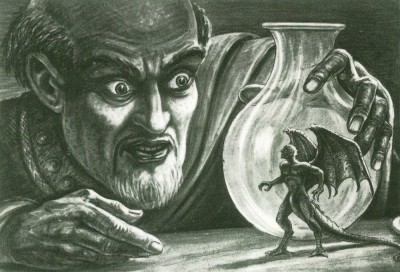 9
9
An early Harryhausen preproduction drawing of the Homonuclus.
 10
10
Kaura and Achmed look on in wonder as
the Homonuclus comes to life.
 11
11
The Homonuclus first tries out its movement.
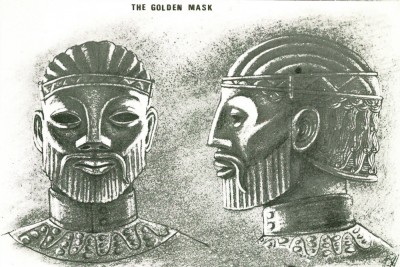 12
12
Designs for the Golden Mask worn by the Vizier whose face
has been disfigured by Koura the Magician.
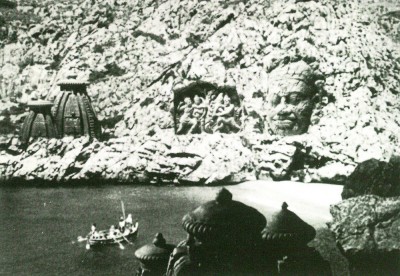 14
14
Beach scenes of Majorca substituted for
the Ancient continent of Lamuria.
 15
15
The construction in the beach wall and the ship were added later.
 16
16
Haryhausen (R) and cinematographer, Ted Moore (L), on the set.
Commentary &Daily post &Puppet Animation 05 Dec 2009 09:46 am
Screenings&Events
Dec 5th – Today is Walt Disney’s birthday. I’ll celebrate by seeing The Princess and the Frog. Nothing like 2D animation to celebrate the man. Maybe later I’ll also watch a couple of great Mickey shorts from the early thirties.
Today’s also the day that we start our fifth year working this blog. It doesn’t feel that long to me, and it still continues to be fun. Hopefully I’ll be able to say the same in another four years.
Mary and Max
- I finally got to see Adam Eliot’s feature, Mary and Max. For those of you unfamiliar with the movie, it’s an animated feature by the Australian creator of Harvie Krumpet, which won the Oscar for animated short in 2003. I won’t go into the story other than to say it’s a penpal tale between a girl in Australia and a Jewish man with Asperger’s Syndrome in NY.
Since I’ve only seen these two films, I can only judge one against the other – with no other references. These are the aspects both films have in common:
. They have excellent, picaresque stories that move forward through their characters’ lives.
. They are narrated rather than played out and have close to no dialogue spoken by the characters. The work is done in clay with very inventive scenes, but animated in a strongly limited way. (Eliot had once boasted that he’d never done a walk cycle in any of this three previous shorts. Indeed, Mary and Max mostly shows them walking from the waist up. There’s one excellent cycle of a very heavy character walking, so Eliot can do it. Or at least one of his animators can; I don’t know if there are any other animators since there’s no credit for animation on the film.)
. Lastly, the celebrity voices are bordering on brilliant. Geoffrey Rush was at least half the film in Harvie Krumpet. In this feature, Philip Seymour Hoffman gave one of the best animation vocal performances of the past several years.
This last bit counts for a lot. The narration can carry you draggingly through a half-hour short like Harvie Krumpet, but in a a feature like Mary and Max it gets a bit tedious regardless of how interesting the story. After a half hour of only three principal voices (narrator: Barrie Humphries/Dame Edna, Phillip Seymour Hoffman, and Toni Collette) you start looking for more, and the film does wear out its welcome a bit. (Eric Bana also has a small, underwritten part.)
I enjoyed this film somewhat, but it’s in a different league from The Fantastic Mr. Fox or Coraline.
John R. Dilworth
- This coming Tuesday, Dec 8th, ASIFA-East will present an evening with John R. Dilworth. The program should promise to be an unforgettable evening of films, conversation . . . and surprises and comedy.
There will be a screening of a number of John’s films including the NY public premiere of John’s most recent short, “Rinky Dink.”
Tuesday Dec 8, 2009
SVA 209 E 23rd Street, 3rd floor amphitheatre
7 PM
Admission: FREE
By the way, ASIFA-East calenders will be on sale at the event ($10 each), as well as some Dilworth merchandise. Get Christmas shopping in while attending this event.
Mad Monster Party

– Can’t get enough Stop-Motion Animation? Fantastic Mr. Fox, Mary and Max, and Coraline have just wet your appetite? Lert’s go back to the creators of the feast – Rankin-Bass. As part of its Tim Burton retrospective, the Museum of Modern Art will be screening today and tomorrow (Dec. 6th and 7th) Mad Monster Party. (I’d personaly prefer to see Daydreamer, The World of Hans Christian Andersen.) Dracula, the Mummy, and Dr. Jekyll and Mr. Hyde plot to gain control of Baron von Frankenstein’s secret weapon during a monster convention. Featuring the voices of Boris Karloff, Phyllis Diller, the movie should be a trip down memory lane.
December 5, 2009, 5:45 p.m.
December 6, 2009, 5:30 p.m.

A drawing by Don Duga who storyboarded the film. __________________
,
UPA

-On December 14th, the Academy of Motion Pictures Arts & Sciences will have a program celebrating the short films of UPA. John Canemaker will host the event with a look back at the studio’s output. Eight rarely seen films will be screened in 35mm.
These will include:
_____GERALD MCBOING BOING
_____MISTER MAGOO’S PUDDLE JUMPER
_____ROOTY TOOT TOOT
_____MADELINE
_____THE TELL-TALE HEART
_____THE UNICORN IN THE GARDEN
_____FUDGET’S BUDGET
_____GEORGIE AND THE DRAGON
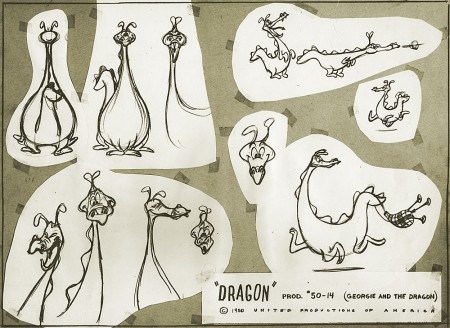
Take it from someone who knows, the collection of shorts couldn’t be better. Lots of Oscar winners and nominees among them. The 35mm prints from the UCLA Archives, will be immaculate. This show will be a treat.
At 7PM December 14, 2009 at the Lighthouse, 111 East 59th Street, between Park and Lexington avenues
$5.00 admission ($3.00 for members)
Animation Artifacts &Articles on Animation &Puppet Animation 22 Sep 2009 07:31 am
Coronet George Pal
 - In April 1944, Coronet Magazine printed an article about George Pal and the making of one of his very successful shorts done for Paramount. He had been nominated for seven Oscars for the shorts which included When Tulips Bloom, John Henry and the Inky Poo, and Dr. Seuss’ The 500 Hats of Bartholemew Cubbins, and he was given a special Oscar in 1943 for his puppet work.
- In April 1944, Coronet Magazine printed an article about George Pal and the making of one of his very successful shorts done for Paramount. He had been nominated for seven Oscars for the shorts which included When Tulips Bloom, John Henry and the Inky Poo, and Dr. Seuss’ The 500 Hats of Bartholemew Cubbins, and he was given a special Oscar in 1943 for his puppet work.
The short featured is Jasper Goes Hunting. This is one of the last of the films featuring this character, a holdover from the racist days of yore. Sort of a puppet version of Harman-Ising’s Bosco.
Pal’s style animated puppetry involved lots of replacement parts. If you wanted to move an arm, you had to create a dozen arms which would be replaced from frame to frame. It’s a very time consuming process and offers lots of opportunity of messing up a shot and having to start over.

(Click any image to enlarge.)
Note that Jerry Beck on Cartoon Brew just recently directed us to an auction
of many of George Pal’s puppets. Some of the puppets for the film featured
in Coronet are among those up for sale. This is the link to the auction.
Art Art &Puppet Animation 06 Sep 2009 07:33 am
Quay Dormitorium
The Brothers Quay have an exhibition on display at Parsons School of Design, 2 West 13th Street on the ground level. It’s on exhibit from now through October 4, 2009.
Stephen and Timothy Quay claim writers Franz Kafka and Robert Walser, animators Walerian Borowczyk and Jan Lenica, puppeteers Wladyslaw Starewicz and Richard Teschner, and composers Leoš Janácek, Zdenek Liška, and Leszek Jankowski among their influences. All of these artists can be felt with each of the constructions on display.
 1
1On entering you see a darkened room with boxes about
the size of your torso – maybe 3′ x 4′ – on display.
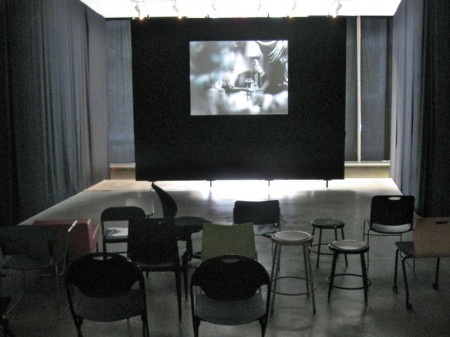
Of to the side there’s a theater with constantly running films
showing Quay brother works. One of every kind of chair.

Within the boxes there are whole worlds.
Magnificent detail upon detail.

To the next box for a wholly different world.

Again the amazing detail is brought to the enclosure.

A couple of the boxes are seen through a prism.
The interior is magnified.

You have to get close to it to get real clarity.
You virtually enter these little rooms.

Some of these worlds seem enormous.

There are many closeups one could take given all there is to see.

This little scene is in the upper left box of the full view above.
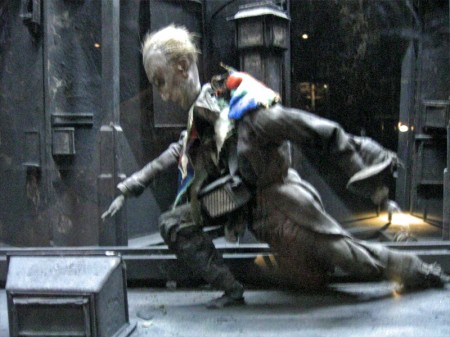
The central character on the main stage.

You can get an idea of the cases and the display.
All contain their own little worlds.

Another magnifying glass focuses on a feather.

Just beyond the feathered quill there’s the writer.

The last box near the exit has a label within.

Many of the cases can be viewed
from three different perspectives.





